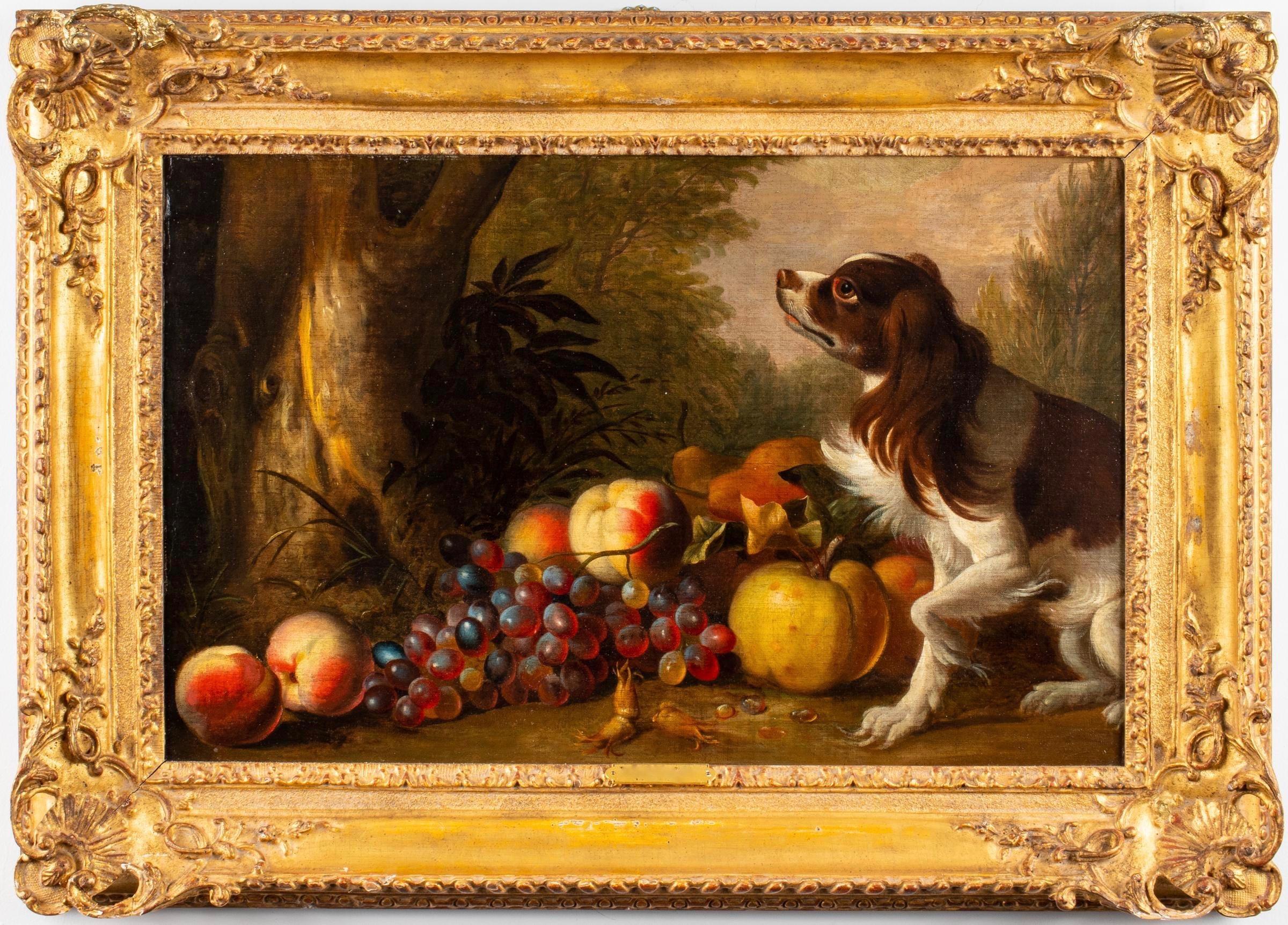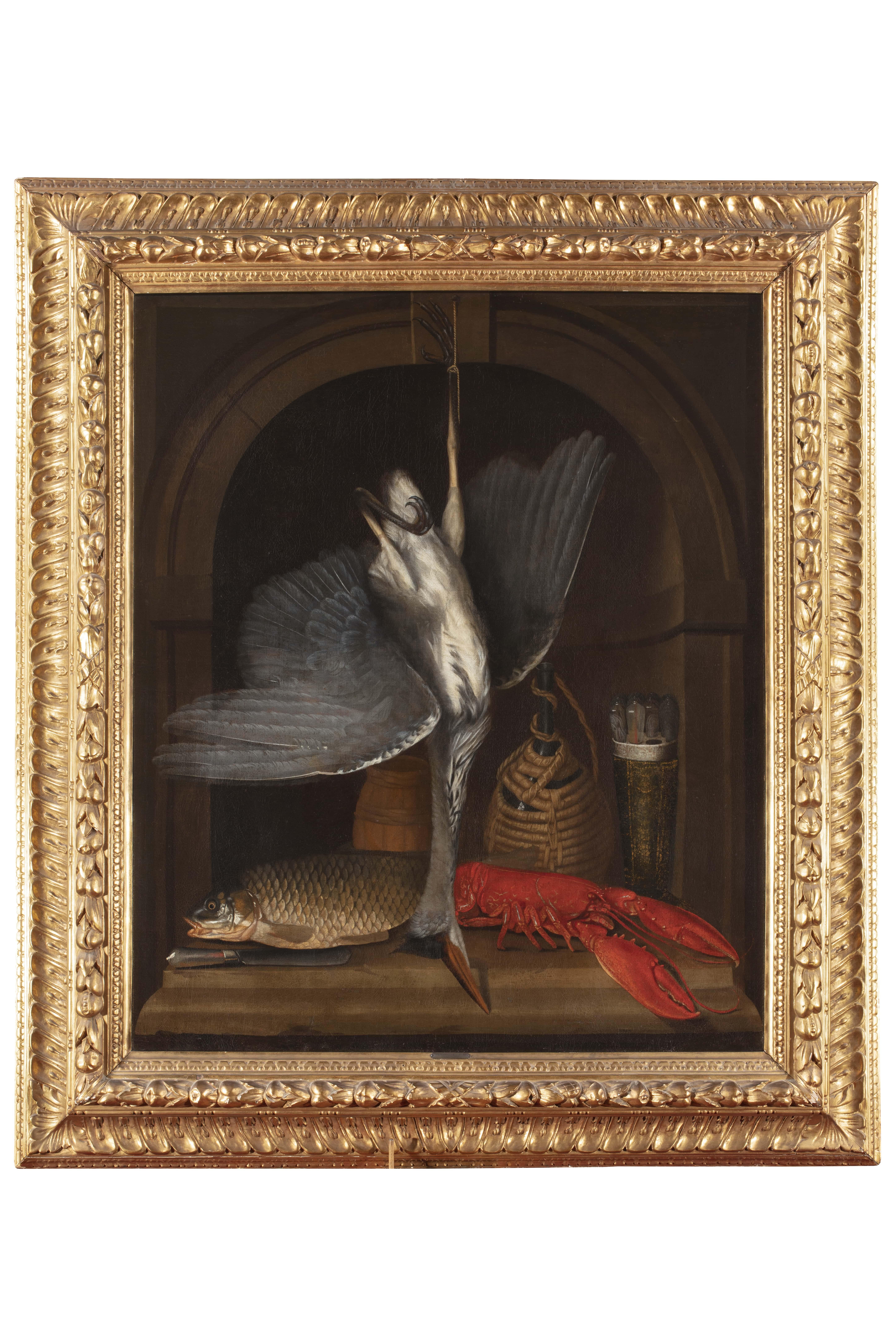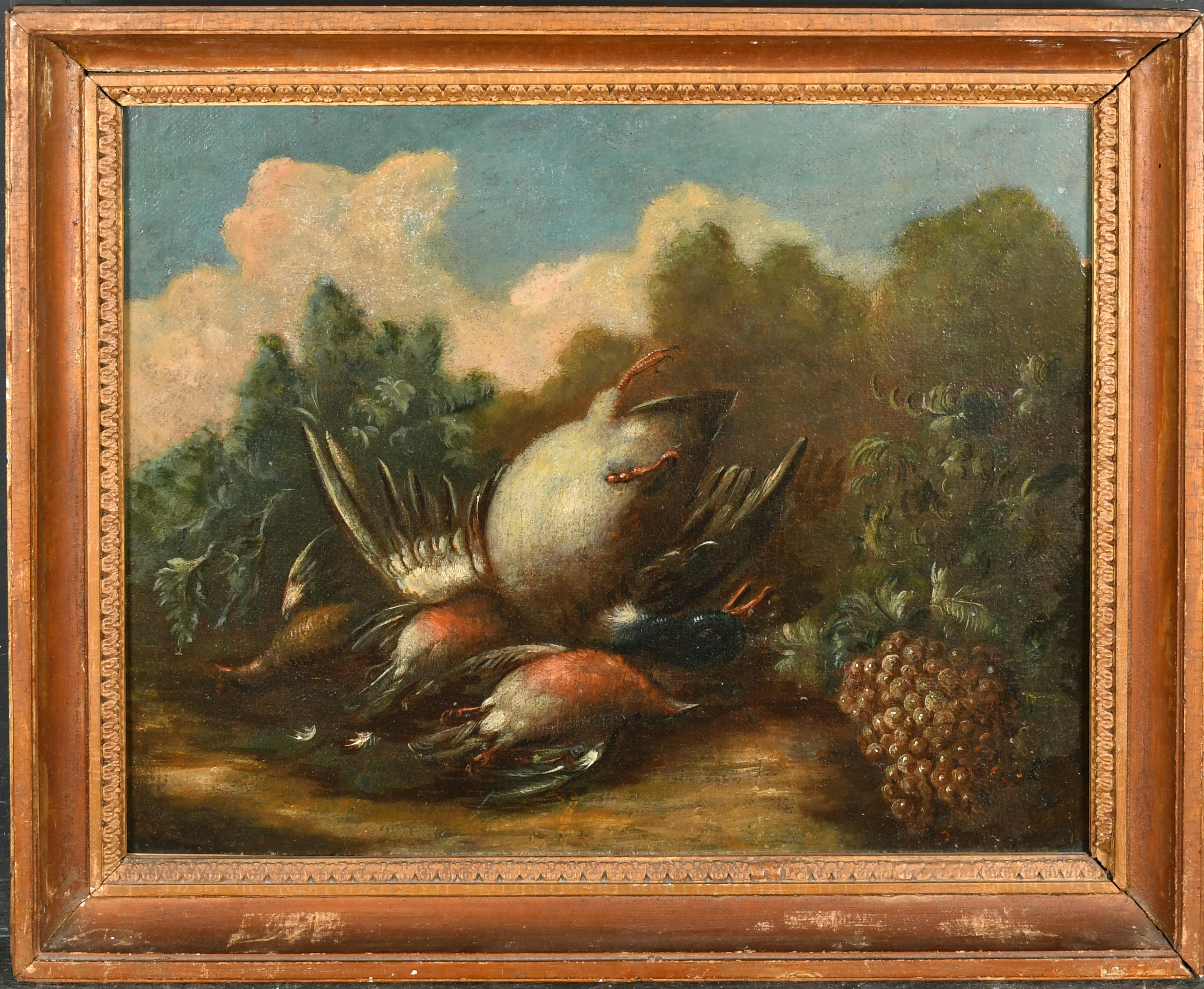Items Similar to Table Top Still Life with Birds, Fruit and Walnuts - Old Master art oil painting
Want more images or videos?
Request additional images or videos from the seller
1 of 17
C L BraunTable Top Still Life with Birds, Fruit and Walnuts - Old Master art oil paintingCirca 1780
Circa 1780
About the Item
This simply stunning German 18th century Old Master oil painting is by noted artist C.L. Braun, signed lower right on the table edge. It was painted circa 1780 and has the look of a Dutch Golden Age Old Master still life painting that one could see in a museum. The composition is a table top with dead birds, two apples, some grapes, a terracotta urn with a silver plate balanced on top with walnuts on it. A peacock butterfly is on a grape leaf. Braun has perfectly depicted the wide variety of materials and textures, from the soft down of the birds under bellies, the smooth bright white flesh of the apple, the gleam of the grapes, the rough terracotta jug and best of all the gnarled matt brown shell of the walnuts reflected in the gleaming silver plate. The detail and colouring is superb. This is a really fine example of an 18th century Old Master German still life oil painting.
Signed lower right.
Provenance. Christie's, London.
David Martin label verso.
Condition. Oil on canvas, 33 inches by 25 inches unframed and in good condition.
Frame. Housed in a fine carved gilt frame, 40 inches by 33 inches framed and in good condition.
C. L. Braun was an 18th century born German artist active in Germany around 1770-80. He painted mainly in oils and painted still lifes in the manner of the Dutch Golden Age Old Masters. His work show cased his artistry in depicting texture and light.
- Creator:C L Braun (German)
- Creation Year:Circa 1780
- Dimensions:Height: 33 in (83.82 cm)Width: 40 in (101.6 cm)Depth: 2 in (5.08 cm)
- Medium:
- Movement & Style:
- Period:1780-1789
- Condition:
- Gallery Location:London, GB
- Reference Number:1stDibs: LU853113070932
About the Seller
5.0
Platinum Seller
These expertly vetted sellers are 1stDibs' most experienced sellers and are rated highest by our customers.
1stDibs seller since 2018
398 sales on 1stDibs
Typical response time: <1 hour
- ShippingRetrieving quote...Ships From: London, United Kingdom
- Return PolicyA return for this item may be initiated within 14 days of delivery.
More From This SellerView All
- Still Life with Game, Fruit and Veg - Flemish 17thC Old Master art oil paintingLocated in London, GBPieter Boel, Flemish Old Master, painted this stunning 17th century still life oil painting. Painted circa 1660 it is a large and impressive still life with dead game surrounded by f...Category
17th Century Old Masters Still-life Paintings
MaterialsOil
- Angling Still Life of Fish - British Edwardian art 1910 oil painting fishingLocated in London, GBThis beautifully composed British Edwardian still life oil painting is attributed to noted fish artist Rowland Knight. Painted circa 1910 it is a still life of salmon and rainbow tro...Category
1910s Realist Still-life Paintings
MaterialsOil
- Portrait of a Boy with Bird - British 17th century art Old Master oil paintingLocated in London, GBThis stunning 17th century Old Master portrait oil painting is attributed to Godfrey Kneller. Painted circa 1680 it is a superb full length portrait of a blonde haired boy holding a struggling bird. He is bare foot and dressed in a white shirt with gold shawl around him. In the background is a blue drape. There is lovely detail and brushwork in his facial features and vibrant colouring. This a superb 17th century Old Master oil painting housed in a lovely frame. Provenance. Two ascribed labels verso Christie's stamp verso. . Condition. Oil on canvas in good condition, 36 inches by 28 inches approx. Frame. Housed in an ornate frame, 43 inches by 35 inches approx. Sir Godfrey Kneller, 1st Baronet (born Gottfried Kniller; 8 August 1646 – 19 October 1723), was the leading portrait painter in England during the late 17th and early 18th centuries, and was court painter to English and British monarchs from Charles II to George I. Kneller was born Gottfried Kniller in the Free City of Lübeck, the son of Zacharias Kniller, a portrait painter. Kneller studied in Leiden, but became a pupil of Ferdinand Bol and Rembrandt Harmenszoon van Rijn in Amsterdam. He then travelled with his brother John Zacharias Kneller, who was an ornamental painter, to Rome and Venice in the early 1670s, painting historical subjects and portraits in the studio of Carlo Maratti, and later moved to Hamburg. The brothers came to England in 1676, and won the patronage of the Duke of Monmouth. He was introduced to, and painted a portrait of, Charles II. In England, Kneller concentrated almost entirely on portraiture. In the spirit of enterprise, he founded a studio which churned out portraits on an almost industrial scale, relying on a brief sketch of the face with details added to a formulaic model, aided by the fashion for gentlemen to wear full wigs. His portraits set a pattern that was followed until William Hogarth and Joshua Reynolds. Nevertheless, he established himself as a leading portrait artist in England. When Sir Peter Lely died in 1680, Kneller was appointed Principal Painter in Ordinary to the Crown by Charles II. For about 20 years (c.1682-1702) he lived at No. 16-17 The Great Piazza, Covent Garden. In the 1690s, Kneller painted the Hampton Court Beauties depicting the most glamorous ladies-in-waiting of the Royal Court for which he received his knighthood from William III. He produced a series of "Kit-cat" portraits of 48 leading politicians and men of letters, members of the Kit-Cat Club. Created a baronet by King George I on 24 May 1715, he was also head of the Kneller Academy of Painting and Drawing 1711–1716 in Great Queen Street, London, which counted such artists as Thomas Gibson amongst its founding directors. His paintings were praised by Whig members including John Dryden, Joseph Addison, Richard Steele, and Alexander Pope. On the landing in Horsham Museum hang works of art from the Museum's extensive painting collection, featuring a large 18th-century portrait of Charles Eversfield and his wife, of Denne Park House. In the painting Eversfield is giving his wife some violets which signifies fidelity, love and honesty. It is likely that the picture was cut down at some time as it was unusual to stop just below the knee. It may have been painted by more than one person: someone who specialised in clothing, another in drapes, and so on, with perhaps Kneller painting the heads, for it was the portraits that gave the sitters their identity, everything else is rather formulaic. He married a widow, Susanna Grave, on 23 January 1704 at St Bride...Category
1680s Old Masters Portrait Paintings
MaterialsOil
- Portrait of William Stonestreet - Dutch Golden Age 17thC art oil paintingLocated in London, GBThis superb Dutch Golden Age portrait is attributed to circle of Dutch artist Wybrand Simonsz de Geest. Painted in 1666 it is a full length portrait of a young William Stonestreet. H...Category
1660s Old Masters Portrait Paintings
MaterialsOil
- Boy with Guinea Pig - British Victorian animal art male portrait oil paintingBy Henry Turner MunnsLocated in London, GBThis charming British Victorian genre oil painting is by noted exhibited artist Henry Tuner Munns. It was painted in 1865 in realist palette with superb detail in the young boy's fac...Category
19th Century Old Masters Portrait Paintings
MaterialsOil
- Arcadian Italian Landscape - Old Master 17thC French oil painting herdsman sheepBy (Attributed to) Gaspard DughetLocated in London, GBA delicate oil on canvas landscape capriccio of an Arcadian landscape with figures and sheep and goats in the foreground. A stormy sky and blasted tree populate the landscape and the...Category
17th Century Old Masters Landscape Paintings
MaterialsOil
You May Also Like
- 18th century portrait of a Spaniel dog with fruit in a wooded landscape.By Tobias StranoverLocated in Woodbury, CTOutstanding early 18th-century portrait of a seated Spaniel dog in a landscape with an array of fruits. Attributed to the work of Tobias Stranover. ...Category
1730s Old Masters Animal Paintings
MaterialsOil
- 17th Century Oil Painting Still Life: Turtles & Fish with a Ship in Stormy SeasLocated in London, GBA Still Life of Turtles, An Eel, Pike, Lobsters and other Fish on the Shore, A Ship in the Stormy Seas Beyond Signed and dated lower left 1640 Inscribed with inventory number lower r...Category
17th Century Old Masters Animal Paintings
MaterialsOil
- 17th century By Dutch maestro Still life with bird, carp & lobster Oil on canvasLocated in Milano, LombardiaThis painting fits well into the Dutch pictorial production of the Golden century. The composition, built on the harmonious presentation of rich wild game and fine details such as th...Category
17th Century Old Masters Still-life Paintings
MaterialsCanvas, Oil
- Fine 18th Century Old Master Oil Painting Dead Game in LandscapeLocated in Cirencester, GloucestershireStill Life with Dead Birds 18th Century Italian School oil painting on canvas, framed framed: 16 x 20 inches canvas: 13 x 17 inches provenance: privat...Category
18th Century Old Masters Animal Paintings
MaterialsOil
- Fine 18th Century Old Master Oil Painting Dead Game in LandscapeLocated in Cirencester, GloucestershireStill Life with Dead Birds 18th Century Italian School oil painting on canvas, framed framed: 17 x 21 inches canvas: 14 x 18 inches provenance: private collec...Category
18th Century Old Masters Animal Paintings
MaterialsOil
- Ten dog studies and a study of a stole, a panel attributed to Jan WeenixBy Jan WeenixLocated in PARIS, FRThis painting is typical of the art of Jan Weenix, one of the best still life and hunting painters of the Dutch Golden Age. In a cleverly disordered manner, he depicts ten studies of dogs (mainly spaniels and greyhounds) and the sumptuous study of a stole. These studies were probably intended to be used as a source of inspiration and adapted in the painter's compositions, as we will see in a close examination of some of his paintings. 1. Jan Weenix, a prolific still life painter Jan Weenix was born into a family of artists: his father Jan Baptist Weenix (1621 - 1659) was also a landscape and still life painter and his mother Josyntgen d'Hondecoeter was the daughter of the animal painter Gillis d'Hondecoeter (1575 - 1638). His father trained him together with his cousin Melchior d'Hondecoeter (1636 - 1695). In 1664 Jan Weenix became a member of the St. Luke's Guild in Utrecht, to which he belonged until 1668. In 1679 he married Pieternella Backer with whom he had 13 children. His compositions, often related to hunting (still lifes, portraits of hunters) were very successful, ensuring him a certain financial ease. Jan Weenix also painted large-scale decorations: while staying in Düsseldorf with the Prince-Elector of the Palatinate between 1702 and 1712, he executed twelve gigantic compositions combining landscapes, hunting scenes and still life for the Bensberg hunting lodge. 2. Description of the artwork The painting displays a great apparent disorder that hides a rigorous organisation in four quarters. It presents ten studies of hunting dogs and one study of a stole. The studies of the stole and of two of the dogs (the greyhound in the lower right and the spaniel in the upper right quarter) are quite elaborate, whereas those of the other dogs are sketchier. As an example, the dog in the upper right corner is only partially painted. The dogs' coats, of different colours - brown, sandy, grey or black - stand out against the warm brown background and are illuminated by the shine of their white hair. This white colour, probably executed with ceruse white, illuminates the study of a stole which stands out in the lower left-hand corner while the red colour of its lining warms up the composition. The purpose of this stole is enigmatic: we think it is probably a neckband, but it could also be the back of the turban of an oriental character. To the right of this stole is the outline of a long animal leg, perhaps a horse leg. Similar studies are rare in the work of Jan Weenix, but the Rijksmuseum recently acquired the study of a seated monkey. This study, executed in the same brown chromatic range, is much more accomplished. It has been reused with minimal change in many compositions. It is likely that Jan Weenix had less frequently a monkey at his disposal, and that he therefore depicted it in great details, whereas he could probably easily find dogs as models. Note the characteristic white dot in the corner of each pupil that brings them to life! 3. Related artworks We have tried to relate the various dogs in this study to the countless dogs that appear in the paintings of Jan Weenix, as listed in the catalogue 'Father and Son - Weenix' compiled by Anke van Wagenberg- Ter Hoeven in 2018. A first example is the painting entitled "The Prodigal Son on the Steps of a Palace" (catalogue number 7 - 8th photo in the gallery). In the lower left-hand corner of the composition, a spaniel is barking at a peacock perched on a stone. This spaniel, which is depicted in a similar manner in the "Portrait of a Young Man with a Falcon" in the Bremen Kunsthalle (catalogue number 76), is reminiscent of the spaniel in the upper left-hand quarter of our study (although the latter is slenderer and the direction of its head differs). We also find, in a slightly different pose, the seated greyhound that is at the top of our painting in the composition representing "A Swan, a Stag, a Hare and Birds presented by two hunting Valets" (catalogue number 130 - last photo in the gallery). The sketch of this greyhound in our study is unfinished: the painter only painted the grey undercoat and the white parts of the coat, without completing the sandy coat which appears in the final painting. We can see from these various examples that our study was probably more a repertoire of forms than a model for a specific composition. The painter probably used it for inspiration before adapting each dog study...Category
Late 17th Century Old Masters Animal Paintings
MaterialsOak, Oil





